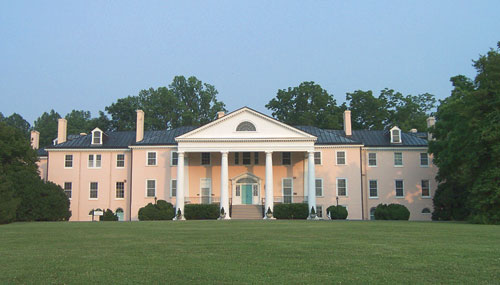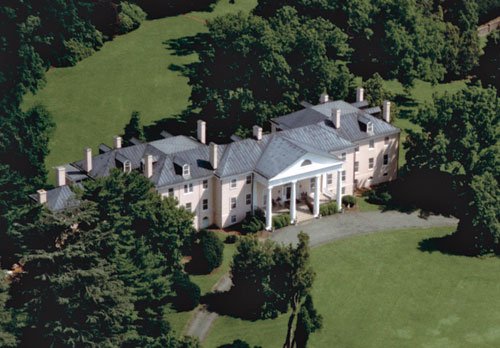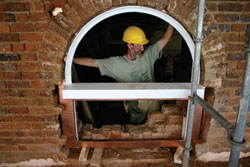Montpelier's Shrunken State Is Fit for a President
Demolition, or "deconstruction," of 23,739 square feet of living spaceÂ-including 29 rooms composing two thirds of the house-were done without compromising any original building fabric, all of which was protected and analyzed. By the end of deconstruction, 10 windows, 17 of the 37 surviving doors, and two fireplace mantels were identified as Madison-era items. Recycled wood panels and boards also gave clues to the appearance of the Madison home. "Despite the DuPont's wealth, they were very frugal-reusing many of the house's original elements in new locations," says Mesick.
When the nearly 2,000 tons of rubble were removed-a foot of soil and a geotextile fabric protected the area around the house for archaeological digs-masons began the exterior restoration by chiseling off stucco that had been applied over the outer brick walls, using hand tools to minimize damage. The first stucco application, believed to have occurred in 1855, consisted of a lime base, causing less damage to the bricks it concealed. Later applications, containing impermeable portland cement, were not as forgiving to the bricks, which were also scarified to accept plaster, particularly on the rear facade.
 |
 |
Prerestoration frontal and aerial views show additions made by William duPont. Photo courtesy The Montpelier Foundation |
Â
Original bricks-archaeological discoveries of kilns confirm they were made on-site-were retained wherever possible; new hand-molded bricks replicating the colors and size of the originals replaced damaged ones. Masons used mortar made from local limestone with added sand from the nearby Rapidan River floodplain-almost the identical ingredients and sources that both James Madison and his father (who built the core of the Montpelier house in the 1760s) had used.
 |
|
A drawing shows the house as it was during Madison's presidency, in color, and later additions (above). Workers install a cellar window (below left) and pull a screed along the capital of one of the portico columns (below right). Drawing courtesy The Montpelier Foundation/MCWB Architects; photos courtesy The Montpelier Foundation |
|
 |
 |
Â
Other major alterations to the exterior, including replacing the wood roof shingles with metal ones, came early on. One of the first owners after Dolley Madison-the property changed hands six or seven times before the DuPonts bought it in 1901-retracted the front porch so that it sat behind the portico's plastered-over brick columns, which were then elongated to meet the ground. Madison, who had consulted often with Thomas Jefferson when he was adding onto Montpelier (Jefferson was renovating Monticello at the same time, and shared the same master builder, James Dinsmore), specified Tuscan columns based on Palladian proportions. "You don't have to know the mathematics behind it to realize what an egregious error it was to lengthen the columns," says John Jeanes, Montpelier's director of restoration.
Jefferson was instrumental in convincing Madison about many of the building elements. One in particular was a sawtooth-shaped metal roof developed by Jefferson himself. It was installed over the north- and south-wing rooms. The serrated form, like a pitched roof, allows water to easily flow away from the building, but has the advantage of permitting a flat deck to be applied over it, creating terraces for the second-floor bedrooms. Later additions placed over these terraces have been removed, and the zigzagging roof replaced. "We wanted in every respect to be faithful to the original building technology," Mesick says, though he added an EPDM rubber membrane between the wood framing and sheet metal "as a belt-and-suspenders approach."









